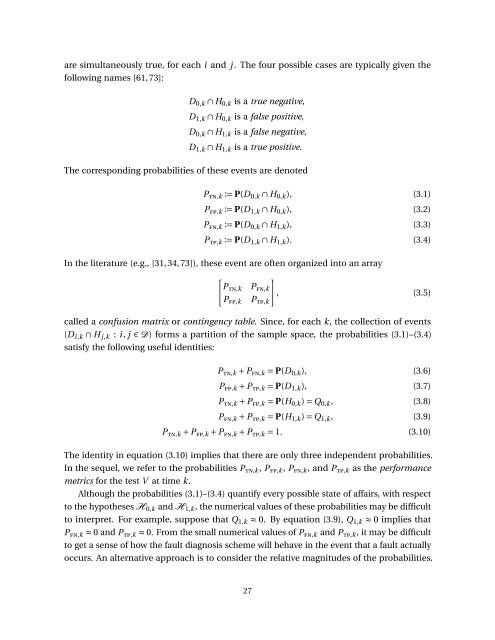Probabilistic Performance Analysis of Fault Diagnosis Schemes
Probabilistic Performance Analysis of Fault Diagnosis Schemes
Probabilistic Performance Analysis of Fault Diagnosis Schemes
You also want an ePaper? Increase the reach of your titles
YUMPU automatically turns print PDFs into web optimized ePapers that Google loves.
are simultaneously true, for each i and j . The four possible cases are typically given the<br />
following names [61, 73]:<br />
D 0,k ∩ H 0,k is a true negative,<br />
D 1,k ∩ H 0,k is a false positive,<br />
D 0,k ∩ H 1,k is a false negative,<br />
D 1,k ∩ H 1,k is a true positive.<br />
The corresponding probabilities <strong>of</strong> these events are denoted<br />
P tn,k := P(D 0,k ∩ H 0,k ), (3.1)<br />
P fp,k := P(D 1,k ∩ H 0,k ), (3.2)<br />
P fn,k := P(D 0,k ∩ H 1,k ), (3.3)<br />
P tp,k := P(D 1,k ∩ H 1,k ). (3.4)<br />
In the literature (e.g., [31, 34, 73]), these event are <strong>of</strong>ten organized into an array<br />
[<br />
]<br />
P tn,k P fn,k<br />
, (3.5)<br />
P fp,k P tp,k<br />
called a confusion matrix or contingency table. Since, for each k, the collection <strong>of</strong> events<br />
{D i ,k ∩ H j,k : i , j ∈ D} forms a partition <strong>of</strong> the sample space, the probabilities (3.1)–(3.4)<br />
satisfy the following useful identities:<br />
P tn,k + P fn,k = P(D 0,k ), (3.6)<br />
P fp,k + P tp,k = P(D 1,k ), (3.7)<br />
P tn,k + P fp,k = P(H 0,k ) = Q 0,k , (3.8)<br />
P fn,k + P tp,k = P(H 1,k ) = Q 1,k , (3.9)<br />
P tn,k + P fp,k + P fn,k + P tp,k = 1. (3.10)<br />
The identity in equation (3.10) implies that there are only three independent probabilities.<br />
In the sequel, we refer to the probabilities P tn,k , P fp,k , P fn,k , and P tp,k as the performance<br />
metrics for the test V at time k.<br />
Although the probabilities (3.1)–(3.4) quantify every possible state <strong>of</strong> affairs, with respect<br />
to the hypotheses H 0,k and H 1,k , the numerical values <strong>of</strong> these probabilities may be difficult<br />
to interpret. For example, suppose that Q 1,k ≈ 0. By equation (3.9), Q 1,k ≈ 0 implies that<br />
P fn,k ≈ 0 and P tp,k ≈ 0. From the small numerical values <strong>of</strong> P fn,k and P tp,k , it may be difficult<br />
to get a sense <strong>of</strong> how the fault diagnosis scheme will behave in the event that a fault actually<br />
occurs. An alternative approach is to consider the relative magnitudes <strong>of</strong> the probabilities.<br />
27













